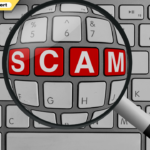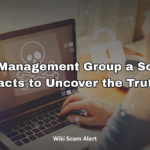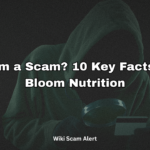Is Afterpay a scam? WikiScamAlert.com dives into this popular Buy Now, Pay Later (BNPL) service, revealing 10 critical facts to know before you shop. Learn how Afterpay works, its risks, and how to stay safe in 2025!
What Is Afterpay?
Afterpay, launched in Australia in 2015, is a legitimate BNPL platform allowing users to split purchases into four interest-free payments over eight weeks. Available at retailers like Urban Outfitters and Target, it’s used by over 8.5 million globally. While convenient, its popularity has attracted scammers, raising concerns about its safety. Check More Here;- Modlily Legit or Scam? 5+Real Reviews & What You Should Know
How Afterpay Works
Users sign up via the Afterpay app or website, select Afterpay at checkout, and pay 25% upfront, with remaining payments due every two weeks. No credit check is required, and approval is near-instant, but late fees ($10 initial, $7 if unpaid after a week) apply if payments are missed. Afterpay doesn’t report to credit bureaus unless negative activity occurs.
Why Scam Concerns Exist
Afterpay’s no-credit-check model and rapid growth make it a target for fraudsters who use phishing texts, fake websites, or account takeovers to steal data or funds. Consumer groups, like CHOICE, warn that BNPL services normalize debt, especially for low-income users, fueling perceptions of risk or scams.
Afterpay’s Security Measures
Afterpay uses SSL encryption and PCI DSS compliance to secure transactions, with fraud detection and two-factor authentication (2FA) to protect accounts. Despite these, phishing scams (e.g., fake “account blocked” texts) persist, requiring user vigilance to avoid fraud.
Protecting Yourself from Scams
To use Afterpay safely, verify communications via official channels (Afterpay.com), use strong passwords, enable 2FA, and avoid public Wi-Fi. Report suspicious texts to Scamwatch or Afterpay’s support. Understanding Afterpay’s operations and risks is key to avoiding fraud in 2025.
Afterpay Facts Overview Table
| Fact Number | Key Point | Implication |
|---|---|---|
| 1 | Legitimate BNPL Service | Not a scam, but risks exist |
| 2 | No Interest, But Late Fees | $10 + $7 if late; caps at 25% |
| 3 | No Credit Check | Easy access, no credit score boost |
| 4 | Phishing Scams Common | Fake texts/emails steal data |
| 5 | SSL Encryption & 2FA | Strong security, user caution needed |
| 6 | Debt Risk for Overspending | Can strain finances if misused |
| 7 | Limited Consumer Protections | Disputes favor merchants |
| 8 | Fraud Losses Low | <1% of sales, but scams persist |
| 9 | Hardship Program Available | Support for payment struggles |
| 10 | Retailer-Dependent Refunds | Returns handled by merchants |
10 Facts to Know Before You Buy

1. Afterpay Is a Legitimate BNPL Service
Details: Afterpay is a regulated company, not a scam, operating since 2015 with millions of users. It’s partnered with major retailers and acquired by Square for $29 billion in 2021. However, scammers exploit its name via phishing or fake websites.
Implication: Trust Afterpay’s official app/website, but verify communications to avoid fraud.
Action: Only use Afterpay.com or the app for transactions; report suspicious contacts to Afterpay.
2. No Interest, But Late Fees Apply
Details: Afterpay charges no interest, splitting purchases into four payments. Missing a payment incurs a $10 fee, plus $7 if unpaid after a week, capped at 25% of the purchase price (e.g., $68 max for orders over $272).
Implication: Timely payments keep it free; late fees can add up quickly.
Action: Set payment reminders or use auto-debit to avoid fees.
3. No Credit Check, No Credit Score Impact
Details: Afterpay doesn’t require a credit check, approving users instantly with spending limits ($400–$2000 based on payment history). It doesn’t report positive activity to credit bureaus, but negative activity (e.g., defaults) may harm your credit.
Implication: Easy access, but no credit-building benefit; lenders may view BNPL as debt.
Action: Monitor spending to avoid overextension; check credit reports regularly.
4. Phishing Scams Are a Major Risk
Details: Scammers send fake texts/emails (e.g., “Your Afterpay account is blocked”) with links to phishing sites that steal login or card details. Some texts include fake verification codes to trick users.
Implication: These scams aren’t Afterpay’s fault but exploit its brand, risking data theft.
Action: Ignore unsolicited messages; verify via Afterpay.com. Report to Scamwatch.
5. Afterpay Uses Strong Security
Details: Afterpay employs SSL encryption, PCI DSS compliance, and 2FA to secure data. It doesn’t store credit card details and uses fraud detection algorithms, with fraud losses under 1% of sales.
Implication: The platform is secure, but user errors (e.g., weak passwords) increase scam risks.
Action: Enable 2FA, use unique passwords, and update the Afterpay app regularly.
6. Overspending Can Lead to Debt
Details: Afterpay’s ease of use may encourage spending beyond means, especially without credit checks. Consumer groups warn it normalizes debt, with late fees adding financial stress for low-income users.
Implication: Not a scam, but misuse can strain finances, mimicking credit card debt.
Action: Budget purchases; only buy what you can repay in eight weeks.
7. Limited Consumer Protections
Details: If a merchant scams you (e.g., non-delivery), Afterpay often sides with the retailer, requiring you to resolve disputes directly. Refunds adjust payments backward, but delays can occur.
Implication: You may still owe payments for undelivered or faulty goods, unlike credit card protections.
Action: Shop with reputable retailers; use a credit card for high-risk purchases.
8. Fraud Losses Are Low but Persistent
Details: Afterpay reports fraud losses at less than 1% of global sales, using machine learning to detect threats. However, account takeovers and identity theft remain issues, especially during high-traffic shopping periods.
Implication: Afterpay manages fraud well, but users must stay vigilant to avoid scams.
Action: Monitor accounts for unauthorized transactions; report issues immediately.
9. Hardship Program for Struggling Users
Details: Afterpay offers a hardship program for users unable to make payments, allowing payment pauses or adjustments. Access requires contacting support, but availability isn’t guaranteed.
Implication: Support exists, but proactive communication is needed to avoid fees or default.
Action: Contact Afterpay early if facing payment issues; document all correspondence.
10. Refunds Depend on Retailers
Details: Returns or refunds are handled by merchants, not Afterpay. If a retailer refuses a refund, you may still owe Afterpay, even for non-delivered items. Full refunds cancel future payments, with paid amounts returned.
Implication: Risk of paying for scam purchases; Afterpay doesn’t mediate disputes effectively.
Action: Review retailer return policies; file disputes with your bank if scammed.
Afterpay Scam Red Flags Table
| Red Flag | Description | Action to Take |
|---|---|---|
| Unsolicited Texts/Emails | Messages claiming account issues | Ignore; verify via Afterpay.com |
| Fake Verification Codes | Texts with unrequested codes | Delete; don’t share codes |
| Suspicious Links | Links to non-Afterpay.com sites | Don’t click; report to Afterpay |
| Urgent Action Demands | Claims of account suspension | Contact Afterpay directly |
| Poor Grammar/Typos | Errors in messages | Flag as scam; report to Scamwatch |
Tips to Use Afterpay Safely
- Verify Communications: Only trust messages from Afterpay.com or the official app; ignore unsolicited texts/emails.
- Enable 2FA: Add two-factor authentication for extra account security.
- Shop Reputable Retailers: Choose trusted merchants to minimize scam risks.
- Monitor Accounts: Check Afterpay and bank accounts regularly for unauthorized activity.
- Report Scams: Notify Afterpay, Scamwatch, or your bank about suspicious activity immediately.
Conclusion
Afterpay is not a scam but a legitimate BNPL service with millions of users and robust security. However, phishing scams, overspending risks, and limited dispute protections require caution. These 10 facts—from late fees to fraud risks—equip you to use Afterpay safely in 2025. Share your experiences on Facebook with #WikiScamAlert!
Frequently Asked Questions (FAQs)
1. Is Afterpay a scam?
No, Afterpay is a legitimate BNPL service, but scammers exploit its name with phishing texts and fake websites.
2. What happens if I miss an Afterpay payment?
You’ll face a $10 late fee, plus $7 if unpaid after a week, capped at 25% of the purchase price.
3. Does Afterpay affect my credit score?
It doesn’t report positive activity, but defaults may harm your credit; lenders may view it as debt.
4. How can I avoid Afterpay scams?
Use strong passwords, enable 2FA, avoid suspicious links, and verify messages via Afterpay.com.
5. What if a merchant scams me with Afterpay?
You may still owe Afterpay; resolve disputes with the retailer or file a bank chargeback.










